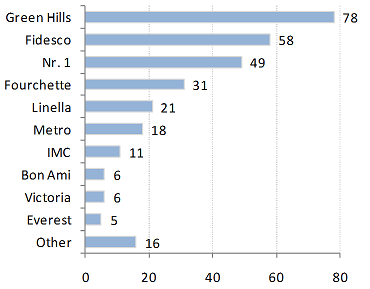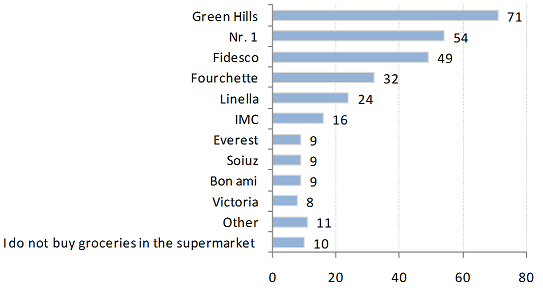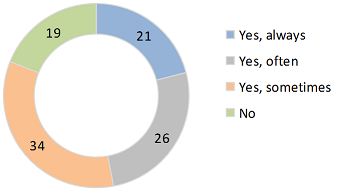The economical crisis can scare out the manufacturers and sellers of many products, but not the representatives of the food industry. Despite the fact that one cannot survive only with bread, eating, is still a life requirement. Some people prefer to buy groceries at the local market, others in convenience stores - Alimentara. From the economical point of view, many argue for buying products at wholesale depots. Another customer segment representing the rational consumer, regularly visits Metro. The younger generations no longer imagine life without supermarkets - warm in winter or refreshing in summer, no wind, a wide range of products, convenient schedule, music in the background... The advantages of the supermarkets are recognized by all visitors; but so are the disadvantages. In most supermarkets you need to master the skills of understanding the price tags that often are misplaced or even missing. Many people at the checkout, come across the situation when some goods are more expensive than indicated on the price tag. Prices themselves are at times indicated per one hundred grams for a particular product, or in other cases - per kilogram. One can get acquainted to this particular science gradually, but even then, it is difficult to consider oneself an expert, as unpleasant surprises occur regularly, even with regular customers.
It's not about the format
If we take a closer look at the food retail market, it is possible to highlight various formats: convenience stores, supermarkets and hypermarkets. In terms of pricing, there are premium, mass-markets and discount stores. The cash&carry format stores cannot be attributed to retailers, because of their fundamental characteristics, which is to focus on wholesale consumers. Abroad, the regular customers for such stores are mostly juridical people engaged in retail trading, representatives of HoReCa, major buyers for various organizations. As understood from the name of this format, the consumers buy the products with cash, consequently having to carry them themselves. Interestingly, the frequent visitors of such local stores are individuals who buy goods for their own household. This explains why the stores Metro were included in the rating of spontaneous notoriety amongst the supermarkets in Chisinau with an 18% share.
Popularity rating
The obvious leader in the ratings - the Green Hills chain, was recalled by 78% of the respondents. Second place belongs to Fidesco (58%). Slightly less than half of the respondents named the supermarkets Nr. 1., Fourchette, which appeared on the market later than its competitors, ranked by 18 percentage points lower than the predecessor. The shops Linella were called out by 21% of the respondents. Various factors influence the notoriety of the supermarket: service quality, product range, and advertising. However, as noted in the popularity rating, the number of stores in the network plays a very important role as well. Thus, the brand name IMC, which has three shops and the brand name Everest, which has only one shop, did not make it into the top five.
Figure 1: Spontaneous notoriety rating, N=628, %

Regarding the visits to the supermarket, the leader in the rankings remained the same - Green Hills, which is visited by 71% of respondents in the capital. On second place is the chain of the Nr. 1 stores - visited by 54% of the respondents. The Fidesco stores are visited by 49% of the respondents. It is important to point out the positive trend for the Nr. 1 chain, in which case the share of visitors is greater than the share of those who indicated these stores amongst the known supermarkets.
Figure 2: Most visited supermarkets, N=589, %

Hunting down the buyers
Supermarkets - a place where food brands flourish. Inside it, takes place a serious struggle for the good spots - the shelves at the eye level. Most often, the well-known commercial brands are found exactly here and thus buyers can "easier" choose. In addition to the packaging and brand, the buyers' attention is drawn to shelf talkers (acrylic or cardboard signs, placed at the end of the shelf), wobblers (pointers that jiggle, which distinguish the goods at the point of sales) and other POS materials. Ironically, the word "crank bait" in English means a big solid bait for catching predatory fish species. It also works for "catching" people with these promotional attention-grabbers. In such cases, the customer forgets about everything - price tag, expiration date, composition of the product. As the study showed, the information about the composition of products is not read entirely and not even always: 19% of the respondents are not at all interested; 34% indicated that they sometimes read this information; a quarter - often (26%); one in five - always reads the composition of the products.
Figure 3: The habit of reading the information about the product contents, N=640, %

Success recipe
Strategically located, talented merchandising assistants and qualitative advertising - the success recipe for any supermarket. Some have taken a step further and provided their customers with discount cards and cards with cumulative bonuses. This triggers people into thinking twice before going to another supermarket, other than "their" supermarket. Nonetheless, after passing by through an entire labyrinth of goods, it is extremely difficult or rather impossible to leave the store empty-handed. Buyers are drawn in so skillfully, so that they return to the supermarket constantly. Consequently, as shown in the study, the proportion of those who do not go to the supermarket, is very low - 10%.
Methodological note. The data was obtained during the study Magenta National Screening. The survey is conducted quarterly with the omnibus method, on a sample of 3,000 people, in villages and towns of the Republic of Moldova, with an error of ± 1.7% and 95% confidence level. The data about the supermarkets was collected only in the capital, with the sample of 680 respondents, and ±4% marginal error.
